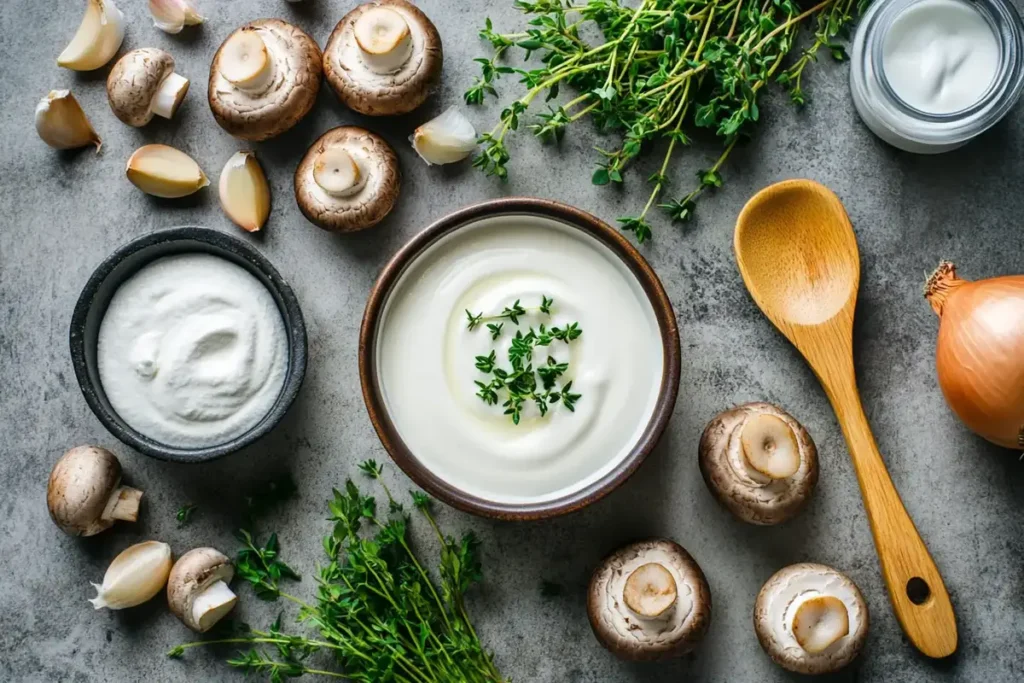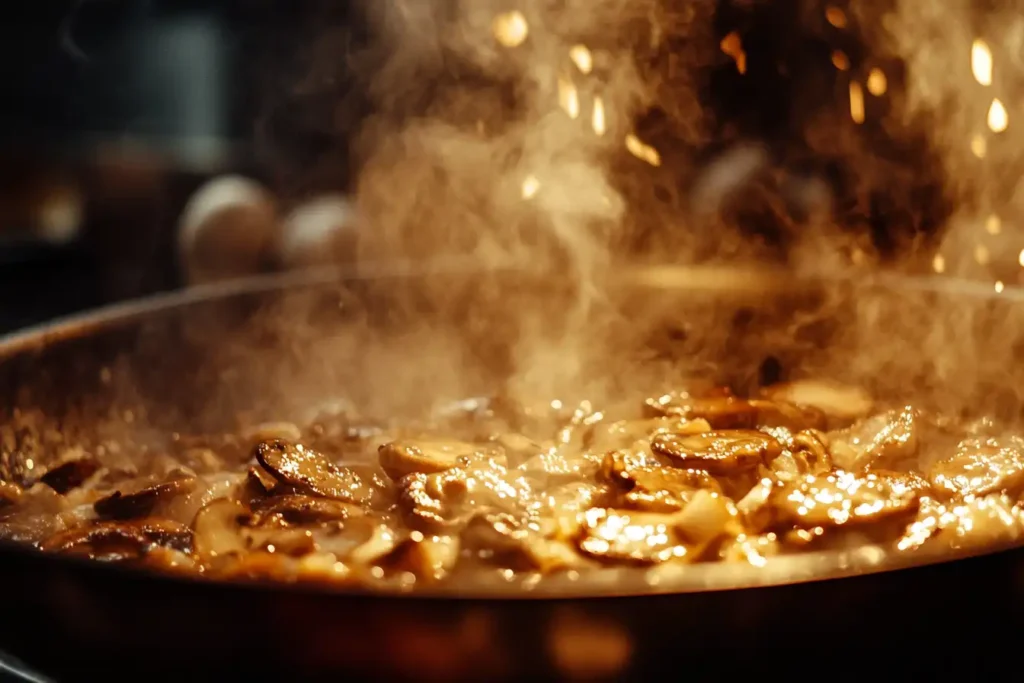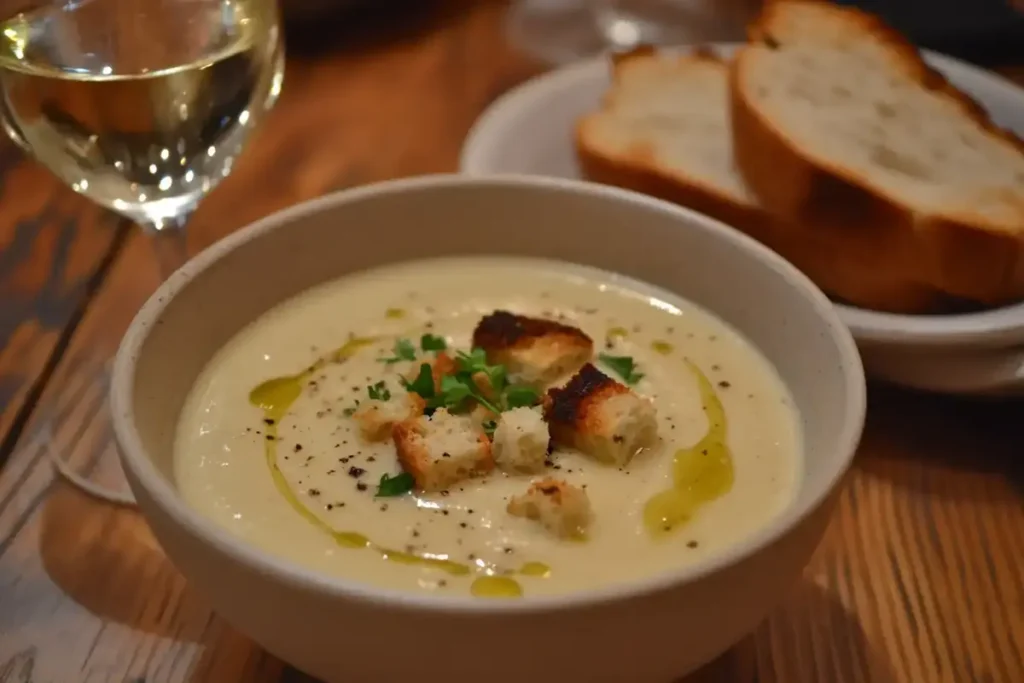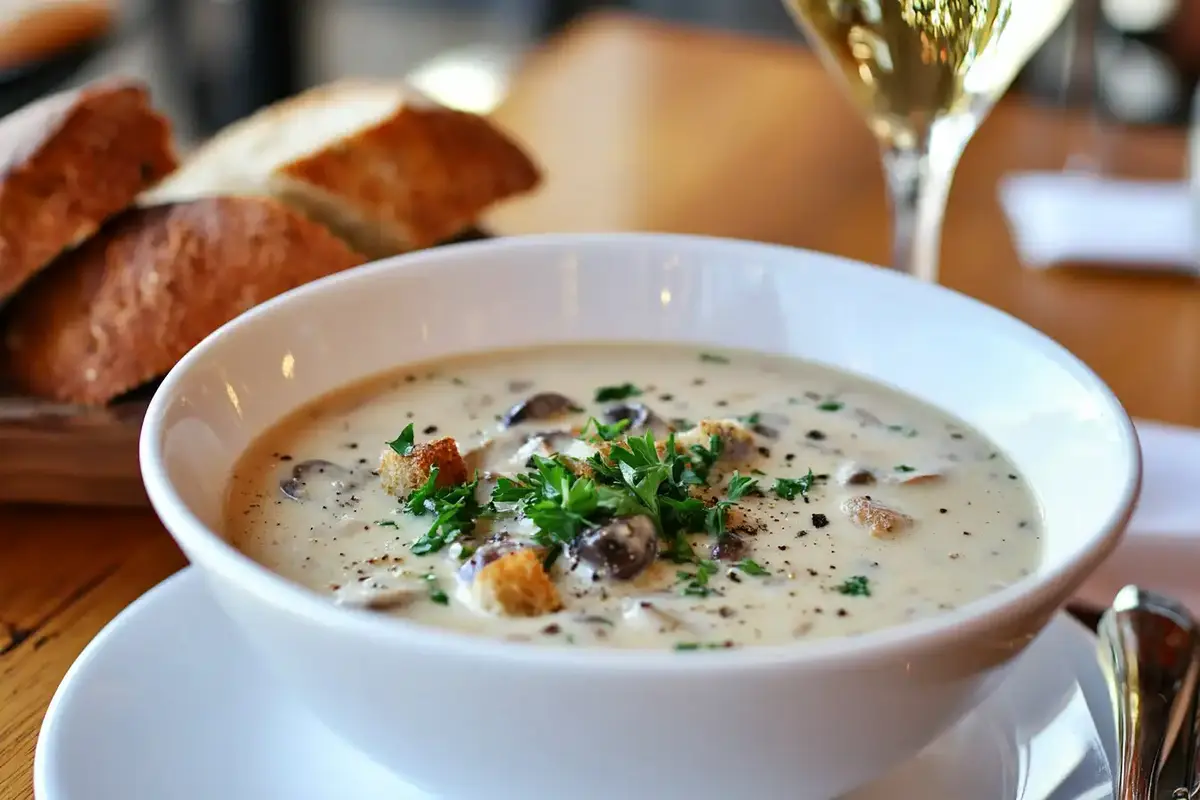Cream of mushroom soup is the epitome of comfort food, loved for its velvety texture and earthy flavors. But sometimes, you may wonder, “What makes cream of mushroom soup taste better?” Whether you’re cooking it from scratch or starting with a canned version, the secret lies in the details. This article dives into every aspect, from selecting premium ingredients to perfecting cooking techniques, and even adding finishing touches that transform your soup into a showstopper. Let’s embark on this flavorful journey, starting with the basics: understanding what makes this dish truly shine.
Understanding the Essence of Cream of Mushroom Soup
The Heart of Comfort Food
Cream of mushroom soup holds a special place in many kitchens because it’s versatile, delicious, and easy to customize. But what sets it apart is its harmonious balance of creamy richness and the savory, umami-packed taste of mushrooms.
A Little History for Context
This beloved dish originated as an easy way to create a hearty meal using simple pantry staples. Over time, it evolved into a gourmet delight, with chefs and home cooks alike experimenting to elevate its flavor profile. Understanding its roots gives us clues about how to make it even better.
Why Taste Matters
At its core, the soup’s success depends on the interplay of quality ingredients, proper techniques, and thoughtful enhancements. Each element plays a critical role in creating that perfect bowl you crave. The right choices can turn a decent soup into one that’s unforgettable.
Key Ingredients That Make or Break It
From the type of mushrooms to the broth and cream you use, every ingredient matters. Freshness, balance, and a touch of creativity are your best friends here. But first, let’s discuss how to select the stars of this dish.
Selecting Quality Ingredients
When it comes to enhancing the flavor of cream of mushroom soup, the ingredients you choose can make all the difference. Using fresh, high-quality items lays the foundation for a rich, indulgent soup that tantalizes the taste buds.
Choosing the Right Mushrooms
Mushrooms are the undeniable stars of this dish, and their type and quality directly impact the taste.
Varieties of Mushrooms
The choice of mushroom can shift the entire flavor profile of your soup. While white button mushrooms are mild and versatile, cremini mushrooms offer a deeper, earthier taste. For a truly gourmet experience, try shiitake or portobello mushrooms. These varieties are packed with umami, which is that savory, meaty flavor that makes this dish so satisfying.
Fresh vs. Dried Mushrooms
Fresh mushrooms are ideal for their tender texture and delicate flavor. However, dried mushrooms bring a concentrated, bold taste that can elevate your soup to new heights. Rehydrating dried mushrooms in warm water not only softens them but also creates a flavorful broth you can incorporate into the soup.

The Role of Aromatics
Aromatics are essential for building depth and complexity. Adding the right ones will infuse your soup with irresistible layers of flavor.
Onions and Garlic
You can’t go wrong with these kitchen staples. Sautéed onions provide sweetness, while garlic adds a warm, pungent kick. Together, they create a flavorful base that complements the earthy mushrooms perfectly.
Leeks and Shallots
For a subtler, more sophisticated flavor, consider using leeks or shallots. Their gentle sweetness and delicate aroma make them a great alternative or addition to onions. Plus, they pair beautifully with creamy textures.
Selecting the Base Liquid
The base liquid serves as the backbone of the soup, amplifying its flavor and texture.
Homemade vs. Store-Bought Broth
Homemade broth is always the gold standard for its freshness and depth, but a high-quality store-bought option works just as well when you’re short on time. Look for broths labeled “low sodium” so you can control the salt level yourself.
Vegetable, Chicken, or Beef Broth
Each type of broth brings a unique flavor. Vegetable broth keeps the dish light and earthy, while chicken broth adds richness. Beef broth, though less common, lends a bold and hearty depth that pairs surprisingly well with mushrooms.
Enhancing Flavor Through Cooking Techniques
The way you cook your cream of mushroom soup is just as important as the ingredients themselves. By using the right techniques, you can unlock deeper flavors and elevate the entire dish. From the art of sautéing to infusing herbs and spices, these methods will transform your soup from ordinary to extraordinary.
Proper Sautéing of Mushrooms
Sautéing mushrooms correctly is a game-changer. This technique brings out their natural umami flavor while adding a golden-brown caramelized touch.
Achieving the Perfect Sear
Start with a hot pan and a generous amount of oil or butter. Add the mushrooms in a single layer, and let them sit undisturbed for a minute or two. This ensures a proper sear, which enhances both flavor and texture. Resist the urge to stir too often; patience is key here.
Avoiding Overcrowding
Overcrowding the pan causes mushrooms to release their moisture, leading to steaming rather than browning. To avoid this, cook in batches if necessary. This small adjustment makes a significant difference in the taste of your soup.

Incorporating Liquids for Depth
Once your mushrooms are sautéed to perfection, deglaze the pan to collect those flavorful browned bits stuck to the surface.
Deglazing with Broth
Using a splash of broth to deglaze the pan adds an immediate burst of flavor. As the liquid simmers, it picks up all the caramelized mushroom bits, enriching the soup’s base.
Layering Flavors with Vegetable Juice
For an extra depth, consider adding a small amount of vegetable juice or tomato puree. These ingredients enhance the savory aspects without overwhelming the soup’s classic mushroom taste.
Utilizing Herbs and Spices
Herbs and spices are the secret to adding complexity and subtlety to your cream of mushroom soup.
Fresh vs. Dried Herbs
Fresh herbs like thyme, rosemary, or parsley provide a vibrant, aromatic quality, while dried herbs offer a more concentrated flavor. Both can be used, but timing matters—add fresh herbs toward the end for a burst of freshness, and let dried herbs simmer longer to release their full potential.
Adding Warm Spices
A pinch of nutmeg or paprika can work wonders in a creamy soup. Nutmeg enhances the creaminess, while paprika adds a gentle smoky note. These spices bring a new dimension to the dish without overpowering it.
The Importance of Layering Flavors
Layering flavors throughout the cooking process ensures every spoonful is rich and satisfying. By sautéing, deglazing, and seasoning thoughtfully, you build a complex and irresistible taste profile that will keep everyone coming back for more.
Achieving the Ideal Texture
A great cream of mushroom soup isn’t just about flavor; its texture plays a vital role in creating that luxurious, satisfying experience. Whether you prefer it smooth, chunky, or somewhere in between, using the right methods and ingredients ensures the soup’s texture matches its flavor perfectly.
Choosing the Right Thickening Agent
The texture of your soup often comes down to how it’s thickened. The right choice can elevate your soup from watery to wonderfully creamy.
Roux Method
A roux—a mixture of butter and flour cooked together—is a classic way to thicken cream-based soups. Not only does it create a velvety texture, but it also adds a subtle nutty flavor. To use this method, cook the butter and flour together until light golden, then slowly whisk in your broth to avoid lumps.
Cream and Dairy Options
The addition of heavy cream, half-and-half, or even whole milk enhances the soup’s creaminess. For a lighter option, consider non-dairy alternatives like oat milk or cashew cream, which also provide a rich texture without overpowering the mushrooms’ earthy flavor.
Blending Techniques
Blending your soup is a quick way to adjust its consistency to your liking.
Smooth vs. Chunky
If you enjoy a silky texture, blend the soup entirely using an immersion blender or traditional blender. For a more rustic feel, blend only half the soup and leave the rest chunky. This approach strikes a perfect balance between creaminess and the texture of whole mushrooms.
Tools for Blending
An immersion blender offers convenience, as you can blend the soup directly in the pot. For ultra-smooth results, a high-powered traditional blender works wonders. Remember to blend in batches if your blender is small, and always let hot soup cool slightly before blending to avoid splatters.
Balancing Creaminess with Lightness
While achieving a creamy consistency is essential, it’s equally important not to make the soup feel too heavy. Balancing the right amount of cream with a touch of broth ensures a lighter yet indulgent texture.
Finishing Touches and Serving Suggestions
The final touches are what set a memorable cream of mushroom soup apart from the rest. Garnishes, drizzles, and thoughtful pairings not only enhance the flavor but also create an inviting presentation that elevates your dining experience.
Garnishing for Enhanced Flavor and Presentation
The right garnish can transform your soup from ordinary to extraordinary, adding visual appeal and a burst of complementary flavors.
Fresh Herbs and Croutons
A sprinkle of fresh parsley, chives, or thyme brightens the soup and adds a subtle freshness to every spoonful. For a delightful crunch, top the soup with homemade croutons or a scattering of toasted breadcrumbs. These additions also help balance the creamy texture with a contrasting bite.
Drizzles and Oils
For a gourmet touch, finish your soup with a drizzle of olive oil or a swirl of cream. If you want to up the ante, a light touch of flavored oil, such as garlic-infused or herb-infused oil, enhances the aroma and adds depth to the dish.

Pairing with Complementary Dishes
Serving cream of mushroom soup alongside the right dishes can turn it into a full meal or an elegant starter.
Bread and Side Options
A slice of crusty artisan bread or a warm baguette is the perfect companion to this creamy soup, ideal for dipping and soaking up every last drop. Alternatively, a light side salad with a tangy vinaigrette provides a refreshing contrast to the soup’s richness.
Serving in Creative Ways
For a sophisticated touch, serve the soup in individual bowls or mugs, garnished to perfection. This presentation works well for dinner parties or cozy gatherings where you want to impress your guests.
Balancing Flavors Until the End
Every detail matters when it comes to finishing a dish. By carefully selecting garnishes and sides, you ensure that every aspect of your cream of mushroom soup experience—from the first glance to the last bite—is absolutely delightful.
Frequently Asked Questions (FAQs)
When making cream of mushroom soup, many questions often arise about its ingredients, techniques, and storage. Below, we address some of the most common queries to ensure your soup turns out perfectly every time.
How can I make my cream of mushroom soup more flavorful?
To boost flavor, start with fresh mushrooms and aromatics like garlic and onions. Properly sauté the mushrooms to bring out their umami-rich notes, and consider adding herbs like thyme or spices such as nutmeg. Using high-quality broth, whether homemade or store-bought, is another key factor.
What types of mushrooms are best for cream of mushroom soup?
While white button mushrooms are a classic choice, cremini mushrooms add a richer flavor. Shiitake and portobello mushrooms offer an even more robust, earthy taste. For a unique twist, combine several types of mushrooms to create a complex flavor profile.
Can I make cream of mushroom soup without dairy?
Absolutely! Replace heavy cream with plant-based alternatives like cashew cream, coconut milk, or oat milk. These options provide a creamy texture without compromising on taste. Non-dairy butter or olive oil can also be used for sautéing.
Elevating Your Cream of Mushroom Soup Experience
Cream of mushroom soup is more than just a comforting dish—it’s a canvas for creativity. By focusing on high-quality ingredients, mastering essential cooking techniques, and adding thoughtful finishing touches, you can transform this classic recipe into something truly unforgettable.
A Recap of Flavorful Tips
From selecting the right mushrooms to perfecting your sautéing technique, every step contributes to the soup’s final flavor. Aromatics like onions, garlic, and leeks create a savory base, while the choice of broth and dairy—or their plant-based alternatives—enhances its depth.
Adding herbs, spices, and garnishes like croutons or a drizzle of oil not only elevates the taste but also turns your soup into a feast for the eyes. Pairing it with crusty bread or a fresh salad completes the experience.
Experiment and Personalize
One of the joys of making cream of mushroom soup is how adaptable it is. Don’t be afraid to experiment with different mushroom varieties, try alternative thickeners, or adjust the seasoning to suit your preferences. Every tweak you make can lead to a delightful discovery.
Your Next Bowl Awaits
With the insights and tips shared in this guide, you’re now equipped to create a cream of mushroom soup that’s bursting with flavor and perfectly textured. Whether you’re enjoying it as a cozy meal or serving it as part of a grander spread, this dish is sure to impress.

